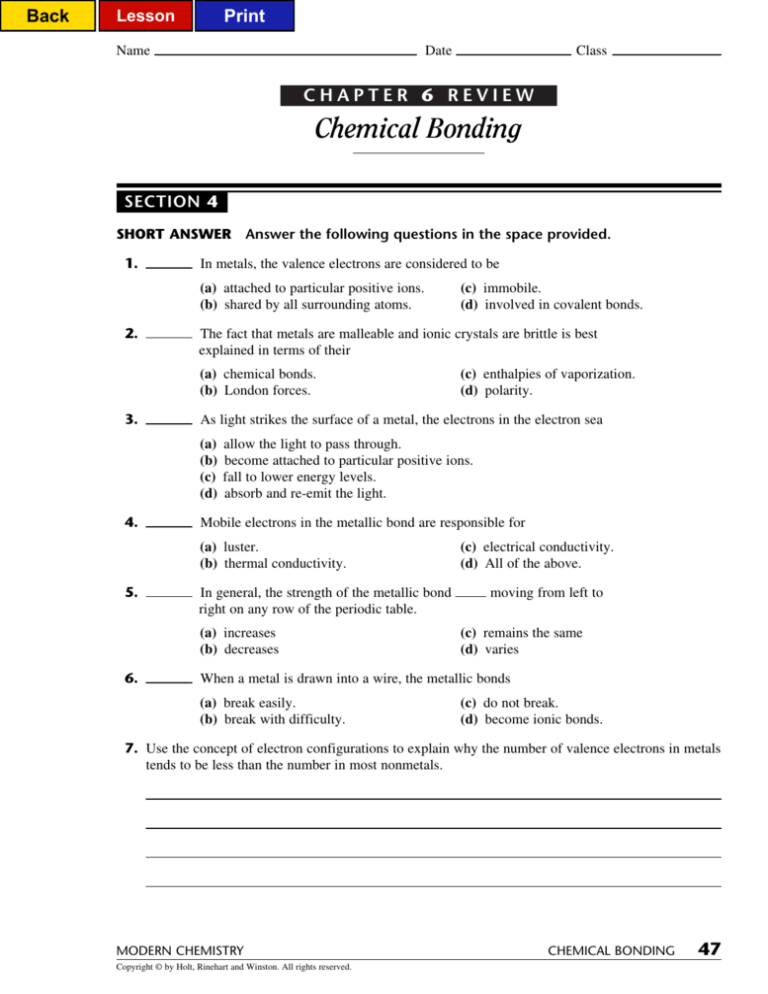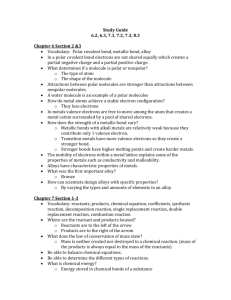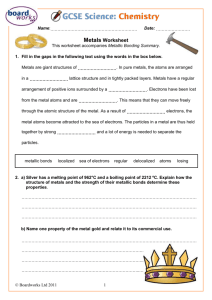
Back
Print
Lesson
Name
Date
Class
CHAPTER 6 REVIEW
Chemical Bonding
SECTION 4
SHORT ANSWER
1.
Answer the following questions in the space provided.
In metals, the valence electrons are considered to be
(a) attached to particular positive ions.
(b) shared by all surrounding atoms.
2.
The fact that metals are malleable and ionic crystals are brittle is best
explained in terms of their
(a) chemical bonds.
(b) London forces.
3.
allow the light to pass through.
become attached to particular positive ions.
fall to lower energy levels.
absorb and re-emit the light.
Mobile electrons in the metallic bond are responsible for
(a) luster.
(b) thermal conductivity.
5.
In general, the strength of the metallic bond
right on any row of the periodic table.
(a) increases
(b) decreases
6.
(c) enthalpies of vaporization.
(d) polarity.
As light strikes the surface of a metal, the electrons in the electron sea
(a)
(b)
(c)
(d)
4.
(c) immobile.
(d) involved in covalent bonds.
(c) electrical conductivity.
(d) All of the above.
moving from left to
(c) remains the same
(d) varies
When a metal is drawn into a wire, the metallic bonds
(a) break easily.
(b) break with difficulty.
(c) do not break.
(d) become ionic bonds.
7. Use the concept of electron configurations to explain why the number of valence electrons in metals
tends to be less than the number in most nonmetals.
MODERN CHEMISTRY
Copyright © by Holt, Rinehart and Winston. All rights reserved.
CHEMICAL BONDING
47
Back
Print
Lesson
Name
Date
Class
SECTION 4 continued
8. How does the behavior of electrons in metals contribute to the metal’s ability to conduct electricity
and heat?
9. What is the relationship between the enthalpy of vaporization of a metal and the strength of the
bonds that hold the metal together?
10. Draw two diagrams of a metallic bond. In the first diagram, draw a weak metallic bond; in the
second, show a metallic bond that would be stronger. Be sure to include nuclear charge and number
of electrons in your illustrations.
a.
b.
weak bond
strong bond
11. Complete the following table:
Metals
Ionic Compounds
Components
Overall charge
Conductive in the solid state
Melting point
Hardness
Malleable
Ductile
48
CHEMICAL BONDING
MODERN CHEMISTRY
Copyright © by Holt, Rinehart and Winston. All rights reserved.
Back
Print
Lesson
Name
Date
Class
CHAPTER 6 REVIEW
Chemical Bonding
SECTION 4
SHORT ANSWER
1.
b
Answer the following questions in the space provided.
In metals, the valence electrons are considered to be
(a) attached to particular positive ions.
(b) shared by all surrounding atoms.
2.
a
The fact that metals are malleable and ionic crystals are brittle is best
explained in terms of their
(a) chemical bonds.
(b) London forces.
3.
d
d
allow the light to pass through.
become attached to particular positive ions.
fall to lower energy levels.
absorb and re-emit the light.
Mobile electrons in the metallic bond are responsible for
(a) luster.
(b) thermal conductivity.
5.
a
In general, the strength of the metallic bond
right on any row of the periodic table.
(a) increases
(b) decreases
6.
c
(c) enthalpies of vaporization.
(d) polarity.
As light strikes the surface of a metal, the electrons in the electron sea
(a)
(b)
(c)
(d)
4.
(c) immobile.
(d) involved in covalent bonds.
(c) electrical conductivity.
(d) All of the above.
moving from left to
(c) remains the same
(d) varies
When a metal is drawn into a wire, the metallic bonds
(a) break easily.
(b) break with difficulty.
(c) do not break.
(d) become ionic bonds.
7. Use the concept of electron configurations to explain why the number of valence electrons in metals
tends to be less than the number in most nonmetals.
Most metals have their outer electrons in s orbitals, while nonmetals have their
outer electrons in p orbitals.
MODERN CHEMISTRY
Copyright © by Holt, Rinehart and Winston. All rights reserved.
CHEMICAL BONDING
47
Back
Print
Lesson
Name
Date
Class
SECTION 4 continued
8. How does the behavior of electrons in metals contribute to the metal’s ability to conduct electricity
and heat?
The mobility of electrons in a network of metal atoms contributes to the
metal’s ability to conduct electricity and heat.
9. What is the relationship between the enthalpy of vaporization of a metal and the strength of the
bonds that hold the metal together?
The amount of energy required to vaporize a metal is a measure of the strength
of the bonds that hold the metal together. The greater a metal’s enthalpy of
vaporization, the stronger the metallic bond.
10. Draw two diagrams of a metallic bond. In the first diagram, draw a weak metallic bond; in the
second, show a metallic bond that would be stronger. Be sure to include nuclear charge and number
of electrons in your illustrations.
a.
b.
weak bond
strong bond
Note: In the strong bond, the charge on the nucleus and the number of electrons
must be greater than in the weak bond.
11. Complete the following table:
48
Metals
Ionic Compounds
Components
atoms
ions
Overall charge
neutral
neutral
Conductive in the solid state
yes
no
Melting point
low to high
high
Hardness
soft to hard
hard
Malleable
yes
no
Ductile
yes
no
CHEMICAL BONDING
MODERN CHEMISTRY
Copyright © by Holt, Rinehart and Winston. All rights reserved.






